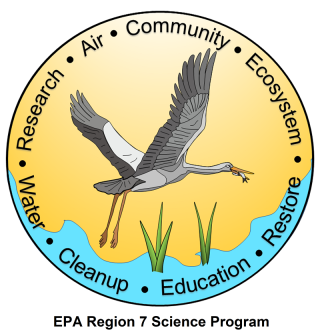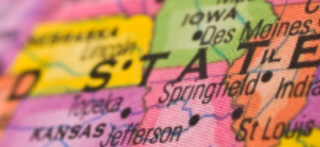Region 7 Science Program
What is the Regional Science Program?

The Regional Science Program links EPA's Office of Research and Development (ORD) with EPA's Regional Offices and emphasizes building networks and partnerships between Regional and ORD scientists, effectively transferring research results on high-priority regional science issues and conducting science outreach to the states, tribes, and communities.
On this page:
- Success Stories
- ORD Research and Small Business Funding Opportunities
- Upcoming ORD Events, Webinars and Training
- ORD Publications, Products, Resources and Toolkits
EPA Region 7’s Science Priorities aim to:
- Study impacts of emerging contaminants such as PFAS, ethylene oxide (EtO), and microplastics.
- Use social science research to assist communities with climate and resiliency planning.
- Evaluate/address climate impacts of harmful algal blooms and nutrients on water resources.
- Develop remote sensing techniques to measure burn areas/impacts on downwind communities.
- Identify preventive and mitigating approaches for community resiliency.
- Develop real-time measurement methodologies to characterize EtO emissions.
- Develop technologies to expedite large-scale, complex mining/mineral processing site remediation.
The cross-cutting Issues of technical support, environmental justice, climate change, and reuse are included in each science priority.
Success Stories
Region 7 Science Academy Webinar Series – Water, Water Everywhere, Nor Not a Drop to Drink: Paths to Water Security
Dr. Kaoru Ikuma, Iowa State University, presented this STAR grantee research project on public trust (or lack thereof) of tap water; community trust and water operators; and developing different tools to support small community decision-making, in case they may want to diversify their water supply.
- View the Aug. 20 recording.
Abstract: In this webinar, Dr. Ikuma presented key findings of various aspects of water insecurity occurring around the United States. Water insecurity is a growing problem in the nation that is compounded by many factors, including environmental injustice, climate change, inflation, supply chain challenges, increasing number of water crises, and decreasing trust in public works.
Even in relatively water-rich regions (including EPA Region 7), water insecurity is a rising concern. In Puerto Rico, where residents frequently have the problem of too much water, hurricanes and geopolitics have resulted in people harboring severe mistrust toward tap water coming from public water systems. In Alaska Native villages, access to piped drinking water does not equal usage. In Iowa, some communities are running out of source water for their drinking water treatment plants and are looking toward water reuse.
This webinar discussed the interactions between various factors that lead to water insecurity; specifically, the observed “mismatches” of people’s trust levels and behaviors toward tap water in Puerto Rico (and briefly Alaska). Findings thus far in our national-scope project on accelerating water reuse in small communities were also discussed. One key takeaway is that, unsurprisingly, diversification of water supplies coupled with good communication to the public are necessary to mitigate water insecurity.
- Learn about the EPA research projects in Puerto Rico, Alaska, and on water reuse.
- "Knowledge-Behavior Gap in Tap Water Consumption in Puerto Rico: Implications for Water Utilities," co-authored by Dr. Ikuma
Water On Wheels (WOW) Cart Demonstration and Presentation
James Goodrich, senior science advisor with ORD’s Homeland Security Research Program, visited Region 7 on Sept. 18, 2024, to present on the Water on Wheels Cart and provide an initial demonstration of the cart’s water treatment capabilities.
Following a natural disaster, communities need access to clean water, not only for drinking but also for cooking, cleaning, and medical triage. If the water system is contaminated, water treatment will be needed.
Bottled water is typically the first responder’s choice when responding to an incident. However, long-term dependence on bottled water creates a large solid waste disposal problem and large vehicles transporting bottled water are often unable to reach affected locations because of road debris and damage.
Utilizing a Cooperative Research and Development Agreement (CRADA) with the nonprofit humanitarian relief organization WaterStep, a prototype mobile emergency water treatment system was fabricated and evaluated at EPA’s Test and Evaluation Facility in Cincinnati, Ohio. Pilot testing confirmed the ability of multiple water treatment processes to be quickly configured to treat sufficient quantities of contaminated water.
Shortly after pilot testing, Hurricane Maria made landfall in Puerto Rico. Within just three weeks, WaterStep’s team was on the ground training emergency workers and distributing kits with components of the second-generation WOW Cart. Learning from both the field challenge and Hurricane Maria, the final version of the WOW Cart was developed.
If you would like additional information, please contact Venessa Madden, EPA Region 7, at 913-551-7794 or madden.venessa@epa.gov.
ORD Research and Small Business Funding Opportunities
Models to Predict the Removal of Emerging Micropollutants from Water by Novel Adsorbents in Fixed-Bed Column Processes – EPA, through the Innovative Water Technology Grant program, is seeking applications for research to develop, test, and deploy predictive models for novel adsorbents and estimate the effectiveness of these adsorbents to remove emerging micropollutants in drinking water and wastewater treatment operations.
- Opened: July 30, 2024
- Closes: Oct. 2, 2024
- Solicitation/Broad Agency Announcement (BAA) number: EPA-G2024-ORD-F1
Developing and Demonstrating Nanosensor Technology to Detect, Monitor, and Degrade Pollutants – EPA, as part of its Science to Achieve Results (STAR) program, is seeking applications for research to develop and demonstrate nanosensor technology with the potential to detect, monitor, and degrade per- and polyfluoroalkyl substances (PFAS) in groundwater or surface water that may be used as drinking water sources.
- Opened: July 31, 2024
- Closes: Nov. 13, 2024
- Solicitation/BAA number: EPA-G2024-STAR-G1
EPA Research Grants – EPA’s Research Grants Program aims to stimulate and support scientific and engineering research that advances EPA’s mission to protect human health and the environment.
- Research Grant Topics (on left at link above): Air Research, Climate Change Research, Ecosystems Research, Health Research, Safer Chemicals Research, Sustainability Research, and Water Research
- Opens and closes: See “Open RFAs” at link above
- Award amounts: Vary by topic
If you are interested in receiving email RFA updates on research funding opportunities, sign up on EPA’s website.
Recording of Region 7 Science Program/ORD Special Webinar: EPA STAR and P3 Program Overview
- Recorded Monday, June 26, 2023
- Want to learn more about ORD’s research funding opportunities for colleges and universities? ORD’s Dr. Intaek Hahn conducted a one-hour webinar on two researching funding opportunities:
- Science to Achieve Results (STAR)
- People, Prosperity and the Planet (P3) Student Design Competition
- Dr. Hahn presented on both STAR and P3, solicitation announcements, criteria, process for submittals, timelines, and the process from submission to award to implementation.
Upcoming ORD Events, Webinars and Training
- Thursday, Oct. 24, 2024, from 10 to 11 a.m. CDT
- Register here
- Tuesday, Oct. 29, 2024, from noon to 3 p.m. CDT
- Informational flyer
- Register here
ORD Water Research Webinar Series – UV Filters in Sunscreens and The Impacts on Aquatic Organisms
- Wednesday, Oct. 30, 2024, from 1 to 2 p.m. CDT
- Informational flyer
- Register here
ORD posts upcoming events, webinars and training several months in advance, which EPA's research staff is participating in, hosting, or supporting in other ways.
Check out the EPA Research Events page often for updates.
ORD Publications, Products, Resources and Toolkits
Strategic Research Action Plans, Fiscal Years 2023-2026
ORD published the FY23-26 Strategic Research Action Plans (StRAPs) for these six National Research Programs (NRPs):
- Air, Climate, and Energy (ACE)
- Chemical Safety for Sustainability (CSS)
- Health and Environmental Risk Assessment (HERA)
- Homeland Security (HS)
- Safe and Sustainable Water Resources (SSWR)
- Sustainable and Healthy Communities (SHC)
As part of the StRAP development process, ORD identified six cross-cutting topics – environmental justice, climate change, cumulative impacts, community resilience, children’s environmental health, and contaminants of immediate and emerging concern – for close coordination throughout strategic research planning and implementation. Importantly, the plans also anticipate emerging issues.
Region 7 had 23 representatives (internal and external) working with ORD to incorporate our science priorities into the StRAP. This is the most involvement Region 7 ever had, and the Region hopes to continue that level of involvement in future StRAPs to address our science needs.
- Updates to Regional Environmental Health Data Visualization Application (REHD) Tool
- EPA Tribal Research Resources
- EPA Science Inventory for Publications
- EPA Science Models and Research Tools (SMART)
- EPA Science Matters Newsletter
- EPA Resources to Support States
- EPA Participatory Science for Environmental Protection
Story Map

Region 7 Science Program’s Research Projects
In this story map, you can learn about the Region’s collaborative research projects that address environmental and health concerns. Extensive details and interactive maps about the 40-plus projects are in six categories: Water, Air, Cleanup and Remediation, Tool/Method Development, Contaminants of Concern, and SBIR/P3/STAR.


